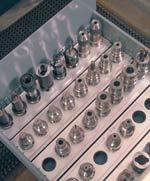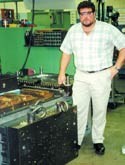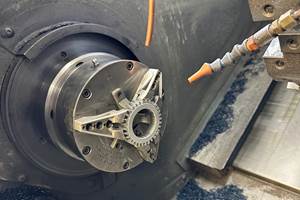Why Use Hydraulic Toolholders
The book on hydraulic toolholders is that they are fussy to set, fragile to operate and expensive to buy. So why do many shops choose them over other holders that seem less demanding? This Chicago mold builder has good reasons for its choice.
Share



GM Tool Corporation (Elk Grove, Illinois) manufactures plastic, diecast and compression molds. The company has been a custom mold builder since its inception in 1965. Its customers are involved in the medical, automotive, consumer products, appliance and computer industries.
The company also understands the production side of injection molding because, in addition to a stable of commercial customers, it also has its own molding division—called Sun Plastics. That company has been in business for 15 years.
A big part of the success of a custom mold shop is keeping itself ahead of competition. “That used to mean beating mold shops in the region,” says GM Tool’s plant manager Ken Moeller. “Today that competition is global.”
For GM, the way to compete is to focus on the tough jobs. “The easy work goes overseas or south of the border,” he adds. “What’s left are jobs that demand the highest skills.” So to play in this market, GM Tool, and companies like it, must not only be good metalcutters, they must also be heavily slanted toward engineering.
While Ken Moeller is responsible for the manufacturing side of GM Tool, his nephew Rick Moeller runs the engineering and programming. GM Tool has seen commercial demands and available technology change its approach to the business. The company has evolved an effective business plan that could be relevant to many other shops in increasingly competitive markets.
Taking Out Guess Work
For a custom mold builder such as GM Tool, the competitive edge flows from engineering. “Our shop is run basically with engineering,” Rick Moeller says. “Data is crucial to development of the tools we build. Our design engineering is done on a Unigraphics platform. It also generates the tool path for our machines. Engineering and machine programming are critical skill areas for our mold shop.”
The output of this strong engineering and programming focus is the ability to, in effect, automate much of the core and cavity machining. Of course, that means carrying the sophistication of the CAD/CAM system to the shopfloor.
DNC is the carrier of this information to the machine tools. GM Tool has been downloading programs to PCs for dissemination on the shop floor for almost 15 years. “We were very early into DNC,” says Mr. Moeller.
Making molds is among the most complex metalworking applications. It involves numerous operations including, in GM Tool’s case, high speed machining of cores, cavities and graphite electrodes for EDM.
Each of the manufacturing process steps depends on the accuracy of the preceding operation. “We try to look at the process as a continuum,” says Mr. Moeller. “At each juncture we look at what is the best technology to bridge to the next step. Of course, as a custom molder, we don’t get second chances. It has to work.”
While this pressure to make it right the first time is often manifested in shops as conservative practice or a resistance to change from the known, GM Tool approaches the problem differently. To keep moving forward, but at the same time keep risk to a minimum, the company does its homework on a potential new tooling, process, or automation enhancement before it becomes integrated into the shop.
Good Tools Need Good Toolholders
To make sure the shop has confidence in its process, rather than letting the process be a limit on capability, GM Tool invests in good quality equipment. The hope is if everything is done correctly upstream, the actual machining of the mold is almost anti-climactic.
About 5 years ago, GM Tool invested in a high speed machining center to improve processing of graphite electrodes for the EDM operations. The company installed an OKK machining center and, because of high speed machining techniques, saw a huge reversal of what was once a bottleneck.
“High speed changed our entire electrode machining process,” says Mr. Moeller. “We applied the Erowa modular workholding system to further automate this part of the mold making process. It has eliminated our need for manual EDM machines. All of our equipment is CNC with orbiting capability and other features to get the finishes demanded by our customers.
“Before getting into high speed graphite milling, we basically machined electrodes by hand or using laminates,” continues Mr. Moeller. “The tool path for machining electrodes is downloaded directly from engineering. Now the operator has time during the machining cycle to perform other tasks. We have much more unattended machining time available with our high speed graphite milling operation.”
High speed machining techniques are also applied to core and cavity production. The company has a Makino V55 for semi-finishing and finishing operations. Like the graphite milling system, automation of the metalcutting process frees up the operator for additional tasks.
In the research into high speed machining, with an eye toward lightly attended or unattended operation, GM Tool knew eliminating variability was critical. This is especially true in mold manufacturing because there is no second chance.
A Key Link In The Chain
Toolholders are one important area of the high speed machining process that got the attention of GM Tool. “Many shops will scrimp on toolholders,” says Mr. Moeller. “In an effort to save a couple of dollars up front, they may end up spending many times more than was saved over the long haul.”
According to Mr. Moeller, GM Tool conducted an extensive search for the right toolholder for the shop. The machine operators were included in the research for the toolholders. “We looked at many different systems of holders, including shrink fit. Our decision boiled down to ease of setup and operation of the hydraulic toolholder.”
For its high speed metalcutting operations, GM Tool chose its hydraulic toolholders from Schunk (Morrisville, North Carolina). Applied on the Makino machining center, the holders are HSK 63, and GM Tool had them balanced at 20,000 rpm to a 2.5g rating. “Having Schunk certify the balance spec of the toolholders was, in part, a requirement of the warranty on the Makino V55,” says Mr. Moeller.
Matching the right technology to a given application is the art of metalworking. For the requirements of GM Tool, the range of cutting tool sizes that can be accommodated by hydraulic toolholders was an important consideration. Using collets, a single toolholder can be used for numerous sized cutters. This, of course reduced the number of toolholders needed.
“One important consideration for using hydraulic toolholders,” says Mr. Moeller, “is they force you to use cutting tools that are highly accurate. The tolerance between the stroke of the hydraulic toolholder and the OD of the cutter is very small. A ½-inch diameter cutter better be very close to ½-inch toolholder tolerance, or the holder will not clamp it as securely. Moreover, the collet system allows us to interchange inch and metric tools sizes if necessary.”
Living With Hydraulic Toolholders
The hydraulic toolholder works by using fluid to compress an internal membrane within the holder body. The hydraulic fluid delivers uniform pressure around the membrane allowing it to compress equally around the periphery of the cutting tool. Basically, that’s how the hydraulic toolholder delivers its high concentricity specs.
In operation, the concentricity of the hydraulic toolholder delivers runout accuracy of 0.00012 inch or less. This translates directly into cutter tool life increases because the chip load on each cutting flute is more uniform.
Using high speed machining techniques such as GM Tool does, the depth of cut is relatively shallow, which makes having a balanced chip load critical. If one of the cutter’s teeth is carrying a heavier load than the others, it will result in premature failure of the cutter, hence shorter tool life. In untended or lightly tended operation, it is vital that tool wear be predictable.
Another benefit of GM Tool’s hydraulic toolholder system is rigidity. Rigidity plays an important role in predictable tool life as well as runout. An HSK interface, with its dual contact face and taper design, provides GM Tool with a rigid connection that is stable both radially and axially. It also provides reliable repeatability when changing tools from the automatic tool changer. Some of the finishing routines can run 15 hours, and for unattended machining cycles it is critical that tool changes repeat accurately.
GM Tool’s machining centers are equipped with through-the-tool coolant capability. The hydraulic toolholders are designed to accommodate this. Both air and coolant can be applied through the toolholder and cutting tool, depending on the material being cut.
“A big advantage for us with this system,” says Mr. Moeller, “is the simplicity of assembling a tool, especially if there is a reduction collet involved. An operator simply slides the collet into the hydraulic chuck bore and then inserts the tool. A turn of the T-wrench and the tool is assembled. The fit is such that no O-rings or bushings are required for through-the-tool coolant use. Even the depth of the tool in the chuck is adjustable.”
Bottom Line Benefit
Like most custom mold builders, GM Tool faces the dreaded customer driven inverse curve of shorter lead times for increasingly more complex molds. To succeed, the company has made the engineering end of the process paramount.
At the same time, measured use of automation in the machining end of the business allows the shop to precisely duplicate what engineering designs. It’s almost a reverse of the way mold shops have historically worked.
The use of high speed machining techniques, along with powerful engineering and machine tool programming software, has helped GM Tool realize a general reduction in throughput of 30 percent over the company’s previous methods. Applying technology is more than just buying good tools. It’s about using good tools effectively for the application with a willingness to look hard at new ways to improve.
Related Content
Chuck Jaws Achieve 77% Weight Reduction Through 3D Printing
Alpha Precision Group (APG) has developed an innovative workholding design for faster spindle speeds through sinter-based additive manufacturing.
Read MoreOrthopedic Event Discusses Manufacturing Strategies
At the seminar, representatives from multiple companies discussed strategies for making orthopedic devices accurately and efficiently.
Read MoreShoulder Milling Cuts Racing Part's Cycle Time By Over 50%
Pairing a shoulder mill with a five-axis machine has cut costs and cycle times for one of TTI Machine’s parts, enabling it to support a niche racing community.
Read MoreEight Articles to Understand Live Tooling
A roundup of the most read articles about live tooling on Modern Machine Shop.
Read MoreRead Next
OEM Tour Video: Lean Manufacturing for Measurement and Metrology
How can a facility that requires manual work for some long-standing parts be made more efficient? Join us as we look inside The L. S. Starrett Company’s headquarters in Athol, Massachusetts, and see how this long-established OEM is updating its processes.
Read More











.jpg;width=860)


















